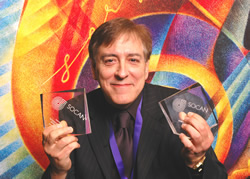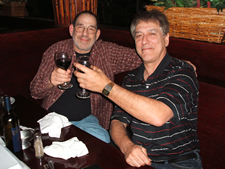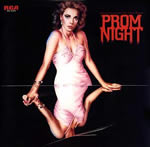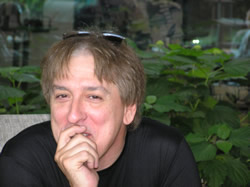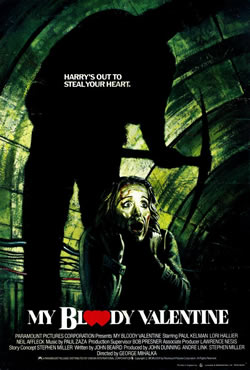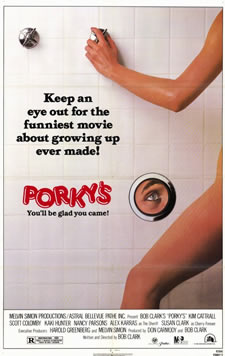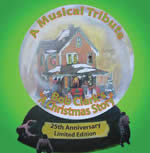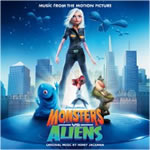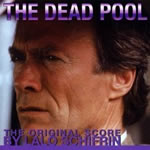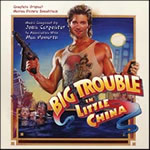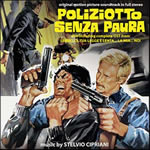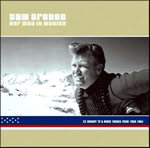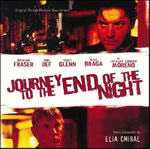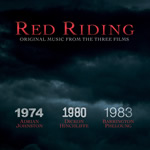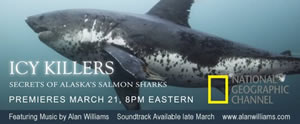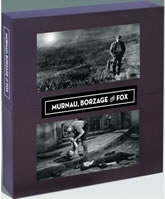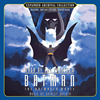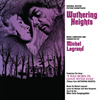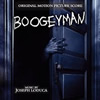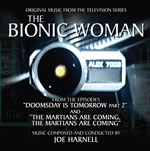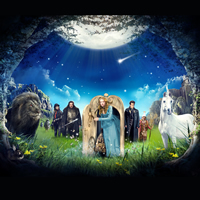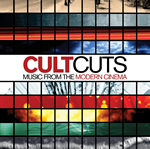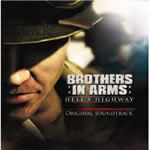 |
Soundtrax: Episode 2009-3
March 23rd, 2009By Randall D. Larson
Paul Zaza Special Occasions:
Music for Prom Nights, Valentines Days,
and Christmas Stories
A Walk Through 1980s Film Scoring with Paul ZazaRemember My Bloody Valentine – the original? How about Prom Night – the original? Hello Mary Lou –Prom Night 2? Porkys? You could poke your eye out with the score to the perennial holiday classic, A Christmas Story! This week we interview a legend of 1980s film scoring – Paul Zaza, who reflects on his work and the style of scoring slasher movies, 1980s style.
This versatile Canadian composer began his career as a classically trained pianist, completing a degree at the esteemed Toronto Conservatory of Music. He has also always had a deep love of rock music, playing bass with the hit musical Hair and touring with the Fifth Dimension in the 1970s. After establishing himself in the world of film and television scoring, Zaza has now over 175 feature films, television series and specials to date to his credit, including Porky's, Meatballs III, A Christmas Story, Prom Night, Derby, Baby Geniuses, Murder By Decree, The Fourth Angel and Grizzly Falls. Zaza is the recipient of many Film and Television Awards including Canada's prestigious Genie Award as well as fourteen SOCAN awards. – from the composer’s web site (see: www.paulzaza.com )
Q: How did you first begin composing for motion pictures?
Paul Zaza: My first composition for a motion picture was actually a fluke. I was earning a living as a recording engineer at the time (recording mostly gospel albums in my studio). It so happened that a composer had booked my studio to record a film score he wrote for a feature film. As it turned out, the director/producer was unhappy with his work and quickly went into panic mode (as they often do). In short, I calmed him down by convincing him I understood what he was looking for and I could write the score his film deserved. Of course I had absolutely NO idea how I was going to accomplish this. But I forged a relationship with him and ended up writing four more of his film scores as well as establishing myself as a Canadian film composer. (The interesting thing in all of this is that I actually had never written a score for anything in my life when I took on this first job). I never told him that until much later in my career.
Paul Zaza with Carl Zittrer Q: One of your first scores was for the Sherlock Holmes/Jack-the-Ripper thriller, Murder By Decree (1979), composed with Carl Zittrer. How did you and Carl work together on this score – and how did you approach the kind of music needed for this dark thriller?
Paul Zaza: Murder By Decree was one of the classiest projects in my career to date. Carl got us the job due to his lifetime relationship with the late Bob Clark. Carl knew instinctively that this score was going to need “weight” with a symphony orchestral score, something that he felt I could handle. We flew to London England and hired the best parts of The Royal Phil orchestra to perform the score I had written. Working closely with the director, Carl then placed the music into the film with some judicious editing. We shared a co-composer credit as a result.
Q: How did you and Carl work begin collaborating together? He’d scored some cool low budget horror films on his own before that.Paul Zaza: Carl had gotten my name from a British Record Producer because he needed someone to produce some low-budget recordings in Los Angeles. He hired me (on behalf of the label he worked for) to arrange, orchestrate, record, and mix the records at my studio in Toronto for a package price – sort of a one stop shopping. The dollar exchange made this very attractive to the Americans. After I successfully completed and delivered over half a dozen records, he left the label because he got a call to go the England for Murder By Decree.
Q: You and Carl also scored the original Prom Night (1980) together. This movie came in the midst of the slasher movie trend of the late 70s/early 80s – but where a lot of those movies used synth scores, Prom Night’s score was orchestral, and had a strong organic sense of suspense and apprehension. How did the two of you approach scoring this slasher movie?
Paul Zaza: Prom Night followed on the heels of Murder By Decree, and, in fact was probably given to us because of our work on MBD. Fundamentally, the same formula was employed given that it worked successfully with MBD. Also, you’re quite right in that synth effects were primitive back then and didn’t fit into the orchestral sound that we chose to use. There were, however treatments of voices that were electronically “cooked” to create a female (crying effect) for some of Kelly’s stalking scenes.
Q: How did you and Carl compose together on MBD and Prom Night? Did you compose cues jointly or take different scenes? How did that work?Paul Zaza: Basically, I wrote the notes on the page as I interpreted what the director wanted for the scene. We would record the piece, and Carl would edit it into the film. Some of the more unconventional pieces (like throwing a bag of nails into the soundboard of a piano) Carl came up with. Much of this sort of thing was used in Prom Night as well as the traditional “music scoring” I provided.
Q: How were you able to get by using an orchestra when so many other slasher films were using, or had to use, synths (or were copying Halloween’s musical style)?Paul Zaza: Personally, I love the power, grandeur, space and subtlety that an orchestra can provide. In my opinion, many of the synth scores that are put on films (especially slasher films) lack the depth, space, and texture that real musicians can supply. It’s a shortcut that uses harsh square waves and dissonance to create tension and horror that can get old real quick, in my opinion. It does have a place in film but should be used in conjunction with other elements. I firmly believe the perfect horror score should have both electronic and acoustic forces used tastefully to create a unique mood the film it is scoring.
Q: In Prom Night the final scenes of the killer’s assault at the prom are mostly covered by disco music (most of which I believe you or Carl also wrote), but some moments bring up your suspenseful string music while the disco beat hovers in the background. How did you work around the omnipresent disco music to help enhance the suspense and shock of the murder scenes?
Paul Zaza: Some fancy editing and sound design work allowed us to run the disco songs (which, yes, I wrote for the movie) at the same time as the dramatic underscore. It was a combination of editing and mixing that made this possible. This was very eerie itself to have a horrific murder happen to a happy dance beat. Further, it kept the audience aware at all times that this killing was going on at the same time as everyone was in the gym having a good time.
Q: Hello Mary Lou: Prom Night II (1987) gave you the opportunity to compose and create some amazingly eerie orchestral, percussive, and synth music and sound design. How did you come up with the approach to this score? It’s a different story, unrelated to the first Prom Night, and so you’ve taken a thoroughly new musical approach to the film.Paul Zaza: Prom Night 2 was a completely different film although it shared the same title. Therefore, I treated it as such and gave it a completely different sound design. The look and feel of it was so radically different than Paul Lynch’s original classic, that I felt it needed a fresh approach with some original ideas not yet heard in the original or any other horror film for that matter.
Q: How specifically did you accomplish some of those eerie sounds in Prom Night 2 that gave it so much of its spooky atmosphere? (synth, sustained strings, harp, percussive pulses, spooky squeals, and so on. Your music for the scene in Vicki’s room where the rocking horse comes to life is just amazing, very provocative and scary).Paul Zaza: Without getting too specific, many of the sounds were what we call “concrete” – meaning they were real analog sounds that were cooked or processed through tape loops, harmonizers, phase shifters, flangers, etc. When married to the orchestral back-drop that the strings provided, the end result would be a very ethereal yet organic blend of human sounds that were musical in nature. This would create quite a disturbing mood for the viewer because it combined the power and emotion of the music with the suspense and fear of a human (say whispering or moaning). It seemed to be appropriate in Prom Night 2 given the long “stalking sequences” that occurred every ten minutes in the film.
Q: In My Bloody Valentine (1981), each of the murders seems to have a different type of musical accompaniment, from strings to reverbed harp to heavy percussion. How did you decide to score the film’s more horrific moments and the build up to them?
Paul Zaza: You’re correct in that there are no two killings alike, therefore I felt that the music for each one should be unique. Given that some of them took place way down in a mine, I tried to emulate that dark, wet, drippy feeling that one would experience if one were actually down there, off to the side observing the murder. This was somewhat accomplished with reverb (echo) and very wet sounding synth patches. This film needed musical stings that “jumped out on top of you” just as the killer often did. When he ultimately did the dirty deed, there was no room for subtlety, as you can imagine. Very often the buildup took a long time and I felt that although the viewer knew what was inevitably coming, he/she didn’t know exactly “when” or “how.” This suspense is what drove the film forward from murder to murder.
Q: In contrast with that, you have also provided a warm love theme for Sarah and TJ, a brief but very sympathetic motif for the killer’s origin flashback, and of course the end title Gaelic ballad that is so memorable and appropriate. How did you use music to help convey a sympathy for the characters that made them so much more real than the usual killer-fodder we find in these types of films?
Paul Zaza: Your observations here are accurate. Actually, the end title song came about because the producer wanted “a song” to play over the closing credits (probably because he thought he could sell a zillion records). He could not afford to license anything because of the small, pathetic budget we had. Naturally, this fell back in my lap and I was told to come up with a song. I stayed up one night and came up with “The Ballad of Valentine” idea. I wrote the lyrics and used a Gaelic motif to create a sort of an East Coast feel – something perhaps that all the people in the small mining town might sing every Valentine’s Day as the years would pass. Thus the legend could “live on” so we could all do a bunch of sequels and get very rich. In fact, it took them over thirty years to do a “re-make” that was just released last month in 3D. Not sure how it did.
Q: Your score for Ghostkeeper (1981) also had an intriguing musical approach. How would you describe your use of music in this film and what elements of the film were most central to your musical choice?Paul Zaza: Ghostkeeper was an unusual mish-mash of many different flavors. The movie itself was disjointed. This is probably why it worked. Again, the use of orchestra and sound processing was employed to create a distorted and off-color mood. Again, female voices were used (I also used them in Curtains [1983]) and processed.
Q: What do you think the slasher movies of the era (late 70s, early 80s) needed in terms of music? How did you create sonic horror to enhance these films’ scariness and impact at the time they were made?Paul Zaza: The genre of these horror movies (especially the 70’s/80’s vintage) had primitive CGI (if any), clumsy electronic music sounds, and cheesy lighting effects. This all contributed to a “look” and “feel” of the genre. One that worked particularly well was Bob Clark’s Black Christmas [1974, scored by Carl Zittrer] where most of the scary music was created by assaulting an innocent grand piano with the sustain pedal down. Remember, that the films of this vintage had no effects or resources at their disposal for two reasons. One was that these technologies were in their infancy stages. The other is that these films had “shoe-string” budgets that were laughable. This forced all of us to be resourceful and frugal with the tiny bit of money at our disposal. We often created horror sounds by running a guitar lick through an echo chamber backwards at half speed or recording a female voice (Prom Night, Curtains) and over-dubbing her ten times a semi-tone apart and playing the ten tracks in reverse at half speed. There were endless possibilities of what we could do to create unique (never-been-heard-before) sounds for each new movie. It was not like today whereby every composer could just buy the latest new gadget, turn it on, and create a masterpiece. (No fuss – No muss.)
Q: With that in mind, then, how has horror film music developed and changed over the almost 30 years since then?Paul Zaza: The music styles advanced as rapidly as did the technology. With the advent of “samplers,” a composer could sample one note (clone) from a symphony orchestra, say, the Boston Pops for example, and create an entire piece from that sample. He would then have the power of that orchestra at his fingertips. While these new techniques put a lot of musicians out of work, it also gave music composers many more useful tools to work with in film. Another by-product of this technological revolution was that we suddenly had many more so-called “Film Composers” on the scene willing to work for nothing. Unfortunately, this sudden influx of supply vs. demand tended to confuse the industry more than it helped it.
Q: The other side of the coin from horror is humor – and you provided a terrific score for another influential film of the era, 1981’s Porky’s. How did you play straight man to the film’s pervasive humor, and how would you contrast your approach to Porky’s with that of your approach to, say, Prom Night or Valentine?
Paul Zaza: Porky’s, being a period piece, needed music with a 50’s sound to it. The music I wrote was intended more to support a “feel” or an atmosphere for the place/period rather than punctuate the jokes on-screen. I felt the actors did that quite well on their own. If I could put the viewer back in Southeast Florida in that era, I felt he/she could experience the vision that the creator (my dear friend Bob Clark) was trying to share with the world. I could accomplish this not by punctuating the already funny sequences, but by playing it straight somewhat and creating the “back-drop” for the scenes.
Q: With Prom Night 3 (1990), you have both humor and horror coexisting in the same film. How did you enhance the multiple layers of this film with your music?Paul Zaza: Prom Night 3 was more of a comic book than a horror film. The gore was so “over-the-top” that it was more hilarious than scary. I don’t think anyone took the film too seriously, it was just meant to be fun.
Q: Prom Night 4 (1992) gave you a fourth opportunity to visit this thematic franchise. While each film is different and shares no similarities other than the prom dance event, how would you contrast your score for the fourth film with the previous three, and how did you try and make this one stand out on its own?Paul Zaza: Prom Night 4, as opposed to 3, had a serious and dark side to it. It was not so much fun like its predecessor. It was set in a monastery, and bordering on sacrilegious, it was intended to be creepy on several levels. It was extremely reminiscent of The Exorcist, and there was a feeling of voodoo and sorcery that permeated throughout. This in itself made it very different than the three Prom Nights before it. For the score, I used a lot churchy sounding music along with some Gregorian Chant Choirs that I concocted for the monastery sequences.
Q: A Christmas Story has become a perennial favorite and a holiday classic. When you first came in to do the score, how did you decide to balance the holiday source music with your original score, and create a musical accompaniment that was married to character and story more so than the Christmas setting?
Paul Zaza: In A Christmas Story we needed to first establish a “Christmas mood” set in a period that existed before most of us alive today were born. The first 20 minutes of the movie did nothing more than just this. Once this was accomplished, the fun could begin with Ralphie and his quest for the Holy Grail. The Christmas feel was never missing in the movie because it was all around you in almost every scene. Further, there was this omnipresent anticipation building throughout the first 80 minutes of screen time that would ultimately be paid-off (or not) on Christmas morning. All the music had to do was to support the action on the screen and play along with it. The film did the rest. Please see review http://www.filmmusicmag.com/?p=2387. I believe writer Daniel Schweiger said it best.
Q: Are there any other film scores that you found especially challenging or memorable?Paul Zaza: There were many challenges along the way and in fact, every film presented its own unique set of challenges. To name a few, here are some of the lesser known films that I feel the music is “noteworthy:” The Fourth Angel [2001] with Jeremy Irons and Forest Whitaker. Unfortunately, this film (about a terrorist airplane hi-jack) was to be released in September 2001 – the month of 9/11. Obviously, the distribution company pulled the film and for good reason. They felt the world was in no mood for a movie with this subject matter after what had just happened. Sadly, it sat dormant long enough for people to digest the horror of 9/11, but unfortunately long enough for the film to become stale and dated. It came out on DVD years later but with limited success. Saltwater Moose [1996] was a delightful children’s movie with some heart. Grizzly Falls [1988] was a wonderful adventure about a boy who is kidnapped by a bear. And Bon Clark’s Turk 182! [1985], an action movie set in New York City, has a lot of soul to it.
Q: It’s been a few years since you’ve scored a film, with Baby Geniuses 2 I believe your most recent. What are your current musical endeavors, and will we be hearing any more of your work in films forthcoming?Paul Zaza: I am currently working on a British television series. The Canadian Film Industry is in dire straits right now and in Hollywood, unless you’re lucky enough to get hired on the latest Comic Book Blockbuster, there’s not much around. This has caused me to look at movies in Europe, India, and even Eastern Europe. Also, since Baby Geniuses 2, three Filmmakers who I’ve worked with for over 30 years have unfortunately passed away. There are a few projects in negotiation.
Q: Looking back, how do you feel your music for TV and movies has developed between the late 1970s and the 2000s?Paul Zaza: I think writers develop and mature with age and experience. Hopefully, I did too. I try not to make the same mistakes I did when I started on my first film. Once again, music evolved over the last 40 years along with the tremendous advancements in technology. After every film score that I successfully completed, I wondered what I could’ve done to have made it better. Of course now, when I listen to the scores from Prom Night, My Bloody Valentine, etc. I must constantly remind myself that I did the best I could with what I had to work with at the time.
New Soundtrax in Review
Lakeshore Records has released the soundtrack to DreamWorks latest animation feature, Monsters vs. Aliens. Featuring a vibrant score by Hans Zimmer/Remote Control Prods’ Henry Jackman along with a handful of recycled rock/pop songs heard in the film, this is a winning release. Jackman, whose classical music training did equal time with expertise learned in contemporary technology, club music, and electronic, gained his apprenticeship at Remote Control Prods providing additional music for The Da Vinci Code, Pirates of the Caribbean 2 and 3, Kung Fu Panda, and others. His orchestral score for Monsters vs. Aliens is lively and fun. The album opens with “A Giant Transformation,” a suitably epic styled cue, with exuding … of orchestra, a provocative female voice, and an onrushing mix of pulsating rhythms opening into teasing phrases of Jackman’s massive melodic theme, punctuated by heavy pounding and clacking drums and a few delineations of unusual sounds bleeding through the mix. “Meet The Monsters” is a splendid cue evoking much of the score’s sense of excitement with its sense of frivolity, energizing a jaunty melodic interlude with all manner of unusual and intriguing textures that briefly come to the fore, including electric guitar, bongos, warbling low woodwind growls, choral intonations, brief snatches of calliope and jazzy organ, and bristling synthetic sound designs. It’s a wonderfully eclectic and effervescent cue. Despite Jackman’s Remote Control Prods affiliation, though, the Monsters vs Aliens score is not a Zimmer score nor does it necessarily sound like one (Zimmer did retain an Executive Music Producer credit). The orchestration is fairly standard not the usual hybrid mix of orchestra and synth/rock rhythms that have become so pervasive these days. But there are some nice quirky instrumental touches laced throughout the score, like the vibrato organ tonality that emerges every so often in the energetic “Battle at the Golden Gate Bridge,” or the flighty violin beats and subtle, Theremin-like wails that appear in the midst of the beautifully bombastic “Imprisoned by a Strange Being.” “March of the Buffoons” is also quite compelling, with its comically martial hyperbole, which ends in a riot of clustered rock-and-roll rhythmatics and percussive dynamics. “Galazar as a Squidling” has a martial cadence as well, although much more bombastic, albeit equally tongue-in-cheek. “Do Something Violent!” comprises an aggressive orchestral attack, a brash but melodic and tonal assault with battalions of horns and driving emplacements of string and wind lines leading the charge. Jackman unleashes his full melody line in “The Grand Tour,” but soon is emblazoning it with more of his likably interesting textural bling. “The Ginormica” is a marvelous nearly-6-minute composition that begins as a pleasing scherzo for winds and strings and wraps it up with a full-on orchestral bombast. The score concludes with “Monster Mojo,” which takes all of those unusual instrumental touches and quirky rhythms and concocts a danceable tune enriched by excessive textural flair and sampled bits of dialog from the film. It’s a marvelously inventive and very likable score. Welcome aboard, Mr. Jackman.
Lalo Schifrin’s fourth and final Dirty Harry score, for the fifth and final film in the series, 1988’s The Dead Pool, is now available through Aleph Records. The 17 years since Schifrin had defined the musical direction for scoring Inspector Harry Calahan and his commitment to crime and punishment (with emphasis upon the latter) in the first Dirty Harry (1971)– and the twenty years since Schifrin has reinvented police action scoring in Bullitt (1968) are telling. The Dead Pool is a far different entity than either of those two scores, although the prominent use of jazz idioms, electric bass, and frequent riffing across action scenes is just as pervasive. But the new score fits into then-contemporary musical mores quite well, with a greater emphasis on synths, including the prominent use of electric guitar, electronic wind instruments, as well as the eerie tonalities of a waterphone to represent the villain’s mad and malevolent thoughts. As Nick Redman aptly puts it in his liner notes, “his fusion of synthesized, midi-driven funk successfully coalesced with a more traditional panoply of instrumental exotica.” Some of it is so then-contemporary that it parts of it sound somewhat dated now; but it was and remains the perfect accompaniment for Harry Calahan circa 1985. From the straight-ahead synth-driven energy of “The Pool” and the crashing rhythms of “Time To Get Up” to the reflective tonalities, mesmerizing harp figures, and eerie mysterioso of the first half of “High And Dry” or the dark, ruthless somberness of “The Last Autograph,” the intricate and purposeful suspense writing in “Kidnap and Rescue,” and the fine interoperability of bass guitar and cello near the ending of “Harpoon,” this is a very interesting and progressive take on Dirty Harry. Schifrin doesn’t repeat the style that worked so well in the first couple of scores, but is definitely playing on new ground here. In fact, his “Dirty Harry” theme doesn’t even appear in the score, and only the dazzlingly melancholy reprisal of Harry’s Love Theme in “The Pier, The Bridge, and The City” links the score motivically with any of the prior Harry scores. “The Car” is a chilling mélange of dangerous pulses and strikes that prelude what will become the film’s central action scene – the chase between Harry and the remote-controlled model car housing a bomb. Like he did in Bullitt, with its archetypal police action score, the actual chase is left unscored, to be driven by the sonic interaction of aggressive engine noises, tire screeches, and the heavy bangs of metal-on-metal. The suspenseful tonalities here (especially the portion between 2:36 and 3:38) contains some brilliant and restrained writing, which will become propulsive only when the music desists and the sounds of the chase begin. The score for The Dead Pool was a short one, barely 35 minutes or so, and Aleph’s album contains every note of it, including a few sections excised from the released film. A lot of cues were short so have been edited together (such as the very distinct sections of “High and Dry” and “The Last Autograph” and other tracks) for better listenability, which works fine.
Despite its relative failure at its contemporary box office, John Carpenter’s Big Trouble in Little China (1986) has gone on to become a cult favorite on home video, and its sense of action, adventure, and humor, sets it apart from most other dark Carpenter horror films. It’s sensibility may have more in common with Carpenter’s first film, Dark Star, than the malevolencies of Halloween, The Fog, or Prince of Darkness. Intentionally avoiding the clichés then inherent in American movies about Chinese characters, Carpenter favored his traditional synthesizer arrangement, collaborating for the fifth time with composer/synthesist Alan Howarth, mixed with hard rock and roll, including a main title song performed by his band, the Coupe De Villes (comprising Carpenter and fellow directors Tommy Lee Wallace and Nick Castle [he who BTW also played Michael Meyers in the first Halloween]). Previously released in part, by Enigma Records in 1986 (9 tracks), reissued by Enigma on CD in 1992, expanded into a 14-track promo CD from Super Tracks in 1996, the complete score is now available on a splendid 2-CD set from La-La Land Records. The score is a hard-edged rock and roll score (dominated by the driving “Pork Chop Express” title music which remains associated with Kurt Russell’s Jack Burton character) with atmospheric elements provided by synths and a variety of sampled Chinese instruments to give it an appropriately but non-stereotypical ethnic flavoring. Carpenter and Howarth made this work by creating Chinese-sounding textures but not trying to replicate Asian musical mores or styles. A track like “Tenement/White Tiger” works because, while it uses very Asian sounding percussive samples, its sensibility is one of action music and not ethnic music. The often subtle ethnicity of the music is found in its timbre, while the direction of the music is very much akin to Carpenter’s signature style (this is especially evocative in “Here Come the Storms,” the epic-sounding rhythm track heard when the three mystical elemental masters invade Chinatown. Side 2 contains the film’s climactic final action cues, three of which are in excess of 7-minutes. They contain a lot of action riffs, most built around the motifs developed for villainous Lo Pan, Victor Wong’s delicious tour bus-driving hero, Egg Shen, and others; many punctuated by a recurring, 3-note jolting drum stinger. A number of new themes are developed for specific moments as well, but the overall sensibility here is one of structured riffing and rhythm, with little melodic material integrated as the film reaches its aggressive high points. Two versions of the end title are provided, a vocal version of the title theme sung by Carpenter, one with added percussion bells and whistles added by the studio. A 5:24 assemblage of various stingers is also included, used in the film as various punctuating score overlays. La-La Land’s release is a limited edition of 3,000 copies and includes a 20-page book with comprehensive notes on the film, its music, and track-by-track commentary by Daniel Schweiger.
Zimmer protégé Ramin Djawadi enters horror territory for the first time with an eloquent and mesmerizing score for The Unborn, released on CD by Lakeshore Records. The film, directed by David S. Goyer (Blade: Trinity, X-Men Origins: Wolverine), is about a young woman who fights a spirit that is slowly taking possession of her. Djawadi, who worked with Goyer on Blade: Trinity and the Blade TV series, had composed a score that is both eloquently sensitive and harshly dissonant and shocking. Tracks like “The Unborn,” and “Circle of Trust” waft movingly with persuasive albeit menacing tonalities, while other tracks contain some incredibly shocking stingers (“Medicine Cabinet,” “Bugs,” “The Doorway’s Open”), spooky sonic sonorities and textures (“Possessed,” “Dybuk”), and raging rhythmic dissonances (“Inhabit the Helpless,” “Sefer Ha-Marot”). The score opens, in “The Unborn, with a keening, perhaps infant-like, synth wailing that develops into a driving string rhythm with a delicate female voice taking an overarching melody line. Eliminating the rhythmic and vocal parts, “The Glove” develops the eerie wailing motif, reflective and anticipatory, an attribute explored further in “Jumby Wants To Be Born Now” through reverberating and mysterioso synth sound design. “Twins” reprises the twangy, warbly synth wail, which may or may not reflect the sound of the developing child’s cry, and places it within a rhythmic womb of self-assured strokes of violins of increasing clarity and force, culminating in the soft, resolute sigh of a woman. The score is terrifically dynamic and propulsively varied, although away from the screen its less horrendously-sounded dissonances may be preferred.
Meliam Music of Spain released a splendid compilation of film music from composer Roque Baños, one of the leading and most interesting composers currently working in Spanish film music. The album, Recopilatorio, came out in 2007 but is well worth procuring for those like me discovering Baños more recently. His thriller score for The Machinist came out in the US on Varese Sarabande in 2004 but it wasn’t until I began listening to his work for director Álex de la Iglesia, things like the wonderfully quirky contemporary Western comedy, 800 Bullets or the brooding horror thriller The Baby’s Room that I really stood up to take notice. This compilation, then is a great opportunity to catch up with his work over the last ten years. Collecting scores that have been released on soundtrack in Spain and plenty of cues that have not, Baños proves both his versatility and his command of music for comedies, thrillers, and ornate historical fantasies like 1999’s El Corazón Del Guerrero (Heart of the Warrior), with its majestic symphonic eloquence. More poignantly, “Nostalgia del mar” from Segunda Piel (1999) is a beautifully restrained and elegant romantic melody, emphasizing piano and strings over a rich array of winds. At 11:20, “Despertar del sueño de la razón” from 1999’s historical drama, Goya in Bordeaux, is a fine progressive, dramatic suite for orchestra and choir and the longest track on the 2-disc recording, which by the way is housed in a hardback book occupied by a 56-page commentary (in Spanish) detailing each film included in the set. Second in length is the 10:25 suite from the pirate drama Alatriste (2006), in which Viggo Mortensen plays the historical Spanish soldier-turned-mercenary of the 17th Century, the orchestral suite is imbued with flavorful touches of flamenco guitar, as is the contemporary thriller The 7th Day (2004). Comedies like 2000’s Masterpiece or 2007’s The Perfect Crime are given eloquent orchestral touches that seem to enrich the straightforward elements in which their comic stories are told. The Biggest Robbery Never Told (2007) is given a sultry Mancini-esque jazz. There are several demo cues included as bonus tracks on the second disc in addition to the two dozen score cues presented across both discs. This is a splendid gallery of fine music from a significant film composer of growing international importance.
Among Digitmovies’ recent releases of rare Italian film music is Poliziotto Senza Paura from Stelvio Cipriani, a 1977 police thriller also known as Fearless or Magnum Cop. As with most scores for the Eurocop genre of this period, the music mixes jazzy action motifs with lounge-ish romantic melodies. It’s lush shag carpeting for this intricate detective drama, lending a provocative and fairly sensual backdrop for the story. Track 5 comprises an especially compelling rendition of the romantic theme, for electric guitar and keyboard over bass, snare, and flutes; the melody is reprised for keyboard over bells, shaker, and brushed percussion in Track 7 (the tracks have no names outside of the first, “Titoli,” and last, “Finale”). Several other variants on this theme as well as more standalone jazz-styled pieces abound; tracks 9 and 10 are especially moody cues, establishing an appropriately urban rhythm and gait. Track 19 is a hyper-dramatic cue for strident electric guitar and, in contrast, soft flute; Track 23 concludes the score with a driving rock rendition of the main theme for keyboards and guitars over bongos. Also included on the album is Cipriani’s complete score (10 tracks) to Sbirro, La Tua Legge è Lenta (1979; Hunted City), a Mafioso drama. The music is similar in tone to Poliziotto, with a gentle keyboard melody whose notes emit a 70s-styled electronic twang. Both are very pleasing scores, and Digitmovies’ continued dedication to preserving these obscure treasures of Italian film music is to be commended.
San Francisco-born composed Sam Spence wound up emigrating to Germany and launching a successful career as a film and television composer in Munich. In the US Spence is known for his music for NFL Films’ series of documentary films on the National Football League, but he has also composed a couple dozen German TV series during the 1970s. All-Score Media of Germany have issued Sam Spence: Our Man In Munich, a notably compilation of Spence’s film music. His music is mostly in the jazz/swing/big band mode, and his themes for the eleven NFL films included here are tuneful and rhythmic. But the highlights are his dramatic film scores, including the James Bond-ish Wie Ein Blitz, a 3-part TV crime thriller from 1970, which are most interesting here. “Pink Blitz,” also from Wie Ein Blitz, is an interesting take-off on Mancini’s Pink Panther tune. Another Bond-ish melody, the title song from 1975’s Queen of Diamonds, is eloquently persuasive. Spence’s music for the 1980 crime-comedy Carnapping is an interesting mix of a provocative synth melody over a big band riff. A trumpet later takes the main melody over a jazzy organ. Spence’s theme for a Unidata Siemens TV commercial is also included, a likeable electronic motif. Three tunes from 1969’s Bitte Recht Freundlich, Es Wird Geschossen are in a prominent big band style, including the raucous dance track, “Do The Samtusi.” Biographical notes on Spence are included in German and English.
Elia Cmiral’s score for Journey to the End of Night (2006), recently released on CD by Perseverance Records, is a change from the composer’s frequent excursions into horror and science fiction. For Eric Eason’s drama of a son and his father separately plotting to escape the desolation of their lives in the lurid underworld of Brazil's sex industry, Cmiral’s experience with dark and horrific subject matter serves this new score well, as he sets up a dark ambiance that characterizes the wicked web into which father and son necessarily fall. Emphasizing electronica bathed in a sensibility of strings and voice (evocatively invoked by Kevyn Lettau), Cmiral sets up a hypnotic musical journey that reflects that of the main characters, delving from light into darkness and ultimately back out again. The score is a tone poem for a dangerous trek tinged by hope and ultimate redemption, but harried by all manner of unrelenting obstacles, tenuous associations, and tested courage. It’s a pervasive ambiance that is both disturbing and compassionate. The package includes liner notes by Daniel Schweiger that describe in detail Cmiral’s intentions and approach to the score. The booklet also includes a note from director Eric Eason (“Elia is like a time traveler. He hurtles between the epochs to bring texture and emotion to his films”). A very nice album, well packaged and well presented musically.
Silva Screen has released an impressive soundtrack to UK’s Channel 4 Television series Red Riding, a series of three feature films, each based on David Peace’s crime thrillers set in Yorkshire in the 70s and 80s; a time of paranoia, police corruption, and the Yorkshire Ripper murders. The three films, named 1974, 1980, and 1983 respectively, were scored by different composers – Adrian Johnston, Dickon Hinchliffe, and Barrington Pheloung – and the soundtrack contains healthy portions of each of their efforts. Johnston’s music set the tone for the series with his moody, ambient, patterns of cello, acoustic guitar, and violins, which drift soothingly across the soundscape and give the show a compelling and persuasive tonal and reflective underbelly. “Paula” and “Never Come Back” are especially moving moments in the score, eloquent and calmly melodic. Hinchliffe follows a similar pattern, emphasizing guitar and strings but adding piano, which invests a neat contrast and a flavorful flair to the sound design in “Your Answer.” Drumset and a rumbling organ provides an intriguing sonority to “To Fitzwilliam,” while the interaction between high strings and deliberately spaced apart paired piano notes in “The Confession” provides an especially evocative cue. “Ripper in the Belly” perhaps characterizes Hinchliffe’s approach best, a compelling rhythm for acoustic guitar, electric guitar, violins, and cello, driven by a soft snare drum and cymbal beat, growing in force and cadence. Both Hinchliffe and Johnston find some unique and disturbing tonal atmospheres for scenes set in the Karachi Club, with three tracks of vastly haunting and reflective tonalities. With “Peace At Last,” Hinchliffe provides a far more up-front rhythm piece for strings over a light rock drum/bass beat, embellished by an underlying stream of fast, rhythmic piano notes. For his episode, Pheloung steps comfortably into the Red Riding sound with a pervasive and multi-layered violin cadence, also emphasizing a soothing resonance from harp in place of Johnston’s and Hinchliffe’s acoustic guitar, but the effect is similar. Cues like “Tragic Beauty” provide a moving melodic ambiance, with “Love Theme” and “Lost Children” both inhabiting tender and affecting string passages over, respectively, cello and low winds in the former and harp and higher winds in the latter. All three scores are similar in concept but different in individual technique; the album as a whole captures a very pleasing and soothing sound that belies the dark nature of much of the films’ drama, centering on human emotions an character interplay for its primal ambiance.
Silva has also released The Music of Batman, a splendid collection of music from the complete Batman silver screen franchise. Masterfully performed by the City of Prague Philharmonic Orchestra, the single disc compilation includes themes and suites from Danny Elfman’s off-centre gothic inspiration from the first two Batman movies by Tim Burton, Elliot Goldenthal’s rousing music from Batman Forever and Batman and Robin, Hans Zimmer and James Newton Howard’s minimalist angst ridden scores from Batman Begins and The Dark Knight, Shirley’s Walker’s magnificent theme from Batman: Mask of the Phantasm, Christopher Drake’s End Credits from Batman: Gotham Knight, and, capping it off, the Neal Hefti and Nelson Riddle’s sixties loungey, brassy, bass-driven beats for Batman TV series. It’s an impressive recording, nicely selected and performed, although a bit skewed toward Elfman’s first Batman score (6 cues versus one each for all the others) – that said, Elfman’s music is arguably the best of the series, having defined and set the tone for human super hero music from that point on. But the music is just marvellous and it thunders and undulates in all its dark heroism for more than 41 minutes. Sequenced together like this, the album makes a fantastic orchestral concert piece, brimming with rousing and provocative music.
Film Scoring News
Alan Williams has scored the new television special, Icy Killers: Secrets of Alaska's Salmon Sharks, which premiers March 21 on National Geographic channel. The soundtrack will be available in late March via Alan’s web site at www.alanwilliams.com . Also, Alan's score to the animated short Pajama Gladiator won the Nicktoons Network Animation Festival's Audience Award and Producers Award. Congratulations, Alan!
The Jeff Kaufman Agency reports that film composer Mark McKenzie has been awarded the 2009 Arvella Schuller Performing Arts Award along with singer/ song writer Rebecca St. James on Saturday, March 14th. The award is given each year to honor a professional who makes positive contributions towards family values in the arts. Mark's original symphonic underscoring from nine family films, including Mi Familia, The Ultimate Gift, The Last Sin Eater, The Lost Child, Saving Sarah Cain, and others. Past recipients have included Tommy Lasorda, Dr. Phil, John Tesh, Nita Whitaker, Don Lafontaine, Dorothy Benham, and Back Street Boys' Brian Littrell. Congratulations, Mark!
Tim Curran has composed music for the new DVD version of Frank Borzage’s 1925 wartime drama, Lazybones. The restored movie is included in the new 20th Century Fox box set Murnau, Borzage, and Fox. Curran designed an intimate score performed by guitars, flutes, and piano. This is Curran’s second classic silent film scoring assignment; the first was a score for the 1928 John Ford classic, Hangman’s House (see my Jan. 14, 2008 column for an interview with Tim on that score).
Marco Werba (Colour From The Dark, Fearmakers) has scored the new Dario Argento horror film, aptly called Giallo. Although the title, rather than referring to the film genre Argento has pioneered, has to do with the villain’s name – the film has an American stewardess and an Italian Detective team up in a race against time to find her sister who has been abducted by a maniacal serial killer known only as “Yellow” (Giallo).
Japanese composer Kenji Kawai has composed the music to Rain Fall, a new Japanese/Australian crime thriller starring Gary Oldham and Kippei Shiina.
Composer Theodore Shapiro recently recording his music for the new Harold Ramis comedy, Year One. Check out ScoringSessions.com for a photo report from the session, which utilized a 75-piece ensemble of the Hollywood Studio Symphony, as well as contemporary band elements.
Soundtrack News
La-La Land Records has now released three new limited-edition soundtracks, a complete score CD for Batman: Mask Of The Phantasm by Shirley Walker (3000 units), the original LP tracks from Michael Legrand's lovely score for the 1970 version of Wuthering Heights (1200 units), and Joseph LoDuca's score for the supernatural thriller Boogeyman (1500 units). – via filmscoremonthly.com
La-La Land has also announced on their web site that later this month they will release John Murphy’s broodingly horrific score for the remake of Last House on the Left. www.lalalandrecords.com
Tribute Film Classics has launched its website at www.tributefilmclassics.com
The latest release from Kritzerland, limited to 1000 units and already sold out, presents the first release of Georges Delerue's complete score to Philippe De Broca's 1964 comedy thriller That Man From Rio.
New Line Records has released a songtrack album of the new Friday the 13th remake which is available now on iTunes, containing various songs of various source and vintage. The album does contain the 3:41 opening title of Steve Jablonksy’s score, which is really nice from the soundbyte, but you can’t buy this track singly – iTunes has put the hated “album only” restriction on the whole album.
This coming, Monday Varese Sarabande will announce four new releases from their CD Club. The label has also announced several upcoming releases of interest: James Newton Howard’s Duplicity (March 24th), Scott Glasgow’s Gene Generation (March 24th), Christophe Becks Phoebe in Wonderland (March 24th), Mark Isham’s Crossing Over (March 31st), Trevor Morris’ music for Showtime’s The Tudors, Season 2 (April 14th), Rachel Portman’s score for the HBO movie about eccentric relatives of Jackie Kennedy, Grey Gardens (April 28th), Brian Tyler’s Fast and Furious (April 28th), Michael Giacchino’s music for the fourth season of Lost (May 12th), and Alexandre Desplat’s score for Stephen Frear’s historical drama Chéri (June 6th).
joeharnell.com presents The Bionic Woman: Doomsday Is Tomorrow Part II / The Martians Are Coming, The Martians Are Coming, featuring music composed and conducted by Joe Harnell for the 1970’s cult television show, The Bionic Woman. Doomsday Is Tomorrow was a two part episode that aired during the show’s second season, about an aging scientist who threatens the release of a doomsday device unless world peace is maintained. The Martians Are Coming, The Martians Are Coming was from the third and final season on NBC about BW’s attempts to solve what appears to be a UFO abduction. For The Bionic Woman, Joe Harnell continued his successful creative collaboration with writer/director/producer Kenneth Johnson, a relationship that includes fondly remembered television projects such as The Incredible Hulk, Hot Pursuit, Cliffhangers, V – The Original Mini-Series and Alien Nation. (The first part of Doomsday Is Tomorrow contained music tracked in from previous episodes of The Bionic Woman such as Kill Oscar, Parts I & III and Return Of Bigfoot Part II, previously issued by joeharnell.com
Also new from joeharnell.com is The Incredible Hulk: The First, Parts I & II, featuring Harnell’s music from a two part episode that aired during the show’s Fourth Season, in 1981. The story begins with David Banner discovering that he was not the first person to study the effects of gamma radiation on human beings and that another man had done so thirty years before. Meant as an homage to the classic Universal Monsters films of the 1940s and 1950s, Joe used the opportunity to score The First in the style of those films. Both of these are exclusive joeharnell.com releases, factory manufactured and limited to 1500 units and professionally mastered by Digital Outland.
Decca will release the soundtrack for The Soloist on April 21st, featuring music by Dario Marianelli along with works by Beethoven (“Eroica”, “Ninth Symphony”) and the haunting “Cello Suite No. 1” by J.S. Bach. The Soloist marks the third collaboration between Marianelli and director Joe Wright (Pride and Prejudice and Atonement). The Soloist is an emotionally soaring drama about the redemptive power of music, journalist Steve Lopez (Oscar® nominee Robert Downey Jr.) who discovers Nathaniel Anthony Ayers (Oscar® winner Jamie Foxx), a former classical music prodigy, playing his violin on the streets of L.A. As Lopez endeavors to help the homeless man find his way back, a unique friendship is formed, one that transforms both their lives. The melodies in the soundtrack for The Soloist are said to vacillate from classical exuberance to severe intensity.
Intrada has released a limited version of Jay Chattaway’s score for Braddock: Missinq In Action III (1988), a splendid follow-up to their recent releases of Chattaway’s Missing In Action (1984) and Brian May’s Missing In Action 2 (1985).
The score by Mark Isham and Cindy O’Connor for the 13-episode Starz TV series Crash, based on the Academy Award winning 2004 movie directed by Paul Haggis and scored by Mark, is now available as on-demand CDR from amazon and via Mark’s web site at www.markisham.com
Howard Shore had started a label for some of his unreleased scores. The music to Doubt, based on a Pulitzer Prize-winning play about a nun who confronts a priest after suspecting him of abusing a student, which stars Meryl Streep, Philip Seymour Hoffman, Amy Adams and Viola Davis, is now available on the new Howe Records label. The score, written for a 17 piece chamber orchestra, features hammered dulcimer, Appalachian dulcimer, harmonium, recorder, Celtic harp, mandolin, Irish bouzouki. Also released on Howe is Shore’s original score to Ellen Kuras and Thavisouk Phrasavath’s debut film, The Betrayal (Nerakhoon), which tells the story of the Phrasavath family’s epic journey from war-torn Laos to the streets of New York. Filmed over the course of 23 years, The Betrayal chronicles the family’s struggle to reckon with that which was left behind while forging a new and difficult life in a foreign land. Shore’s score features Sophie Shao on solo cello, chamber orchestra and chamber choir. Both albums are now available via amazon, iTunes, and other retailers. Or see www.howardshore.com
MovieScore Media has released the score to Moonacre, an epic adventure film based on Elizabeth Goudge’s award-winning children’s book The Little White Horse. The film was directed by Gabor Csupo, who made the acclaimed Walt Disney family movie Bridge to Terabithia, and starring Ioan Gruffudd, Tim Curry and Natascha McElhone. The inspired orchestral score by Christian Henson (Severance, Chasing Liberty) reflects the elegance and magic of the story, and is a colorful fantasy film score in the best of cinematic traditions. Beautiful themes, dark and foreboding suspense music, exciting action music and moments of both innocence and humor form the backbone of the soundtrack. Highly original portions of the score include glassware smashing and fingersnaps!
MovieScore Media has also released Gast Waltzing’s score for JCVD, the surprise hit film starring Belgian action star Jean-Claude van Damme as himself, features an infectious big band score that ought to please fans of 1970s action thriller scoring, ala Schifrin, Shire, and Don Ellis. This is the label’s second album with Gast Waltzing, Luxemburg's most prominent film composer and jazz musician. JCVD is perhaps the complete opposite of MSM’s earlier Watlzing release, the grand symphonic fantasy score for George and the Dragon. Accompanying the tongue-in-cheek character of the film (“a French-language meta-movie parody par excellence” according to Variety), Waltzing’s score is “horn-heavy score is pleasingly old-school and subtly parodic” (again, from Variety). A strikingly bouncy main theme, which appears in several different versions, is juxtaposed with bleak string suspense, improvised jazz trumpet parts and percussive action scoring. - www.moviescoremedia.com
Silva Screen Records has released Cult Cuts – Music From The Modern Cinema, a newly-recorded compilation of music from cult favorite film scores, from Lalo Schifrin’s supremely jazzy Bullitt score to Howard Shore’s resonant theme to The Departed. Other highlights include powerful themes from Kill Bill (Tomoyasu Hotei’s scintillating Battle Without Honor Or Humanity and Bernard Herrmann’s spooky Twisted Nerve), Chinatown, Brokeback Mountain, 300, Solaris, The Hours, and many more – an 18-track compilation of landmark film music which has inspired score composers over the last forty years. The label also will be releasing the soundtrack to Eran Creevy’s Shifty, a film based on his teenage experiences that tells the tale of two friends reunited for twenty-four hours, one with a responsible lifestyle, the other a drug dealer. Composers Molly Nyman and Harry Escott perfectly capture the mood of the film with an electronically processed chamber score. A composing team, since 2001, Molly and Harry composed the score for Michael Winterbottom’s A Mighty Heart (2007), the award winning film Road To Guantanamo (2006), Nick Broomfield’s feature film Ghosts (2006) and a controversial American thriller Hard Candy (2005). They have also written numerous TV scores including New Europe with Michael Palin (BBC), Great Britons (BBC), Monarchy (Ch4) and The Victoria Cross Heroes (Five). www.silvascreenmusic.com
Lakeshore Records will release the soundtrack for Sunshine Cleaning, Christine Jeffs’ off-beat dramatic comedy about a single mom and her slacker sister who find an unexpected way to turn their lives around. The soundtrack is now available digitally (iTunes and Amazon Digital) can be found in stores on March 24, 2009. The score was composed by Michael Penn (Boogie Nights, The Anniversary Party); he is the brother of actors Sean and Chris, and chose a career in music rather than follow his brothers into acting.
Games Music News
Emmy-winning composer Jim Dooley has scored the videogame adaptation of Monsters vs. Aliens, coming later this month from Dreamworks Animation and Activision. Check out ScoringSessions.com for a photo report on the scoring sessions.
Composer Joris de Man has scored the new Playstation 3 videogame Killzone 2.
Sumthin Else has released a soundtrack cd for the latest Brothers In Arms game, Hell’s Highway, featuring an orchestral and choral score by Ed Lima (Empire Earth, Doom) and Duncan Watt (Need For Speed: Undercover, Stargate Online TCG). “Composing music that must be at once both familiar and altogether new for this third chapter of the award-winning saga was a welcome challenge,” wrote Lima in the album’s liner notes. “I decided to explore some of the farther reaches of the instrumental palette in Hell’s Highway, introducing the piano as a featured melodic instrument… male voices came to represent valor and camaraderie… female voices symbolized Baker’s sense of responsibility for the wellbeing of his men… the horrors of war are represented by the sounds of the glass harmonica, an instrument so eerie sounding it was once through to be the creation of the devil himself.” Added Watt: “Seldom does a composer get an opportunity to work on a project with so many ties to real-life persons and events. “The historical accuracy of the Hell’s Highway story, combined with our recording in Prague, a city so closely tied to the war… created some interesting parallels. One cue called for a small group of musicians to play as if they were in an impromptu parade, celebrating the liberation of their town… Thinking that some of these musicians, either through their own or their parents’ experience, knew all too well exactly what they emotion meant and knowing we were recording not so far away from where the actual event we were describing happened… was pretty emotional.”
Randall Larson was for many years senior editor for Soundtrack Magazine, publisher of CinemaScore: The Film Music Journal, and a film music columnist for Cinefantastique magazine. A specialist on horror film music, he is the author of Musique Fantastique: A Survey of Film Music from the Fantastic Cinema and Music From the House of Hammer. He now reviews soundtracks for Music from the Movies, Cemetery Dance magazine, and writes for Film Music Magazine and others. For more information, see: www.myspace.com/larsonrdl
Randall can be contacted at soundtraxrdl@aol.com

